Juan Gómez-Luna
PAPI: Exploiting Dynamic Parallelism in Large Language Model Decoding with a Processing-In-Memory-Enabled Computing System
Feb 21, 2025Abstract:Large language models (LLMs) are widely used for natural language understanding and text generation. An LLM model relies on a time-consuming step called LLM decoding to generate output tokens. Several prior works focus on improving the performance of LLM decoding using parallelism techniques, such as batching and speculative decoding. State-of-the-art LLM decoding has both compute-bound and memory-bound kernels. Some prior works statically identify and map these different kernels to a heterogeneous architecture consisting of both processing-in-memory (PIM) units and computation-centric accelerators. We observe that characteristics of LLM decoding kernels (e.g., whether or not a kernel is memory-bound) can change dynamically due to parameter changes to meet user and/or system demands, making (1) static kernel mapping to PIM units and computation-centric accelerators suboptimal, and (2) one-size-fits-all approach of designing PIM units inefficient due to a large degree of heterogeneity even in memory-bound kernels. In this paper, we aim to accelerate LLM decoding while considering the dynamically changing characteristics of the kernels involved. We propose PAPI (PArallel Decoding with PIM), a PIM-enabled heterogeneous architecture that exploits dynamic scheduling of compute-bound or memory-bound kernels to suitable hardware units. PAPI has two key mechanisms: (1) online kernel characterization to dynamically schedule kernels to the most suitable hardware units at runtime and (2) a PIM-enabled heterogeneous computing system that harmoniously orchestrates both computation-centric processing units and hybrid PIM units with different computing capabilities. Our experimental results on three broadly-used LLMs show that PAPI achieves 1.8$\times$ and 11.1$\times$ speedups over a state-of-the-art heterogeneous LLM accelerator and a state-of-the-art PIM-only LLM accelerator, respectively.
SwiftRL: Towards Efficient Reinforcement Learning on Real Processing-In-Memory Systems
May 07, 2024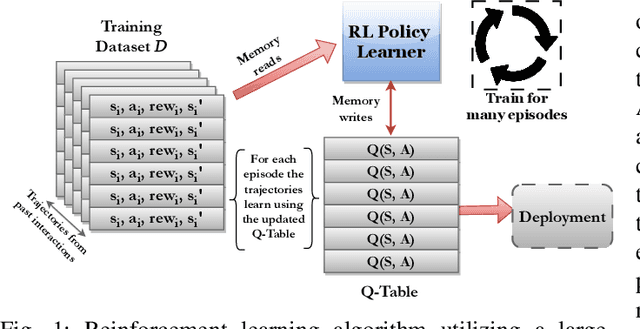
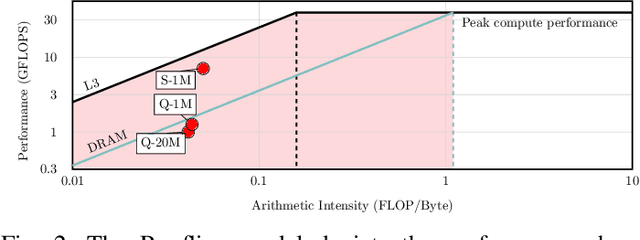
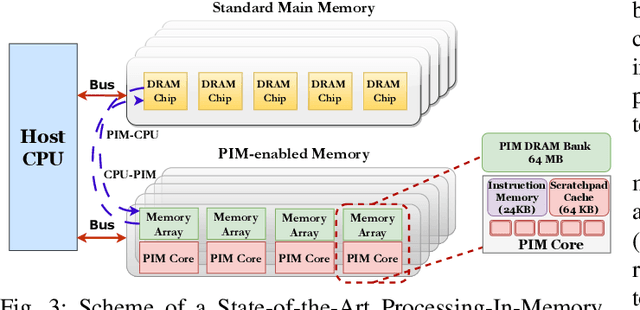

Abstract:Reinforcement Learning (RL) trains agents to learn optimal behavior by maximizing reward signals from experience datasets. However, RL training often faces memory limitations, leading to execution latencies and prolonged training times. To overcome this, SwiftRL explores Processing-In-Memory (PIM) architectures to accelerate RL workloads. We achieve near-linear performance scaling by implementing RL algorithms like Tabular Q-learning and SARSA on UPMEM PIM systems and optimizing for hardware. Our experiments on OpenAI GYM environments using UPMEM hardware demonstrate superior performance compared to CPU and GPU implementations.
Analysis of Distributed Optimization Algorithms on a Real Processing-In-Memory System
Apr 10, 2024



Abstract:Machine Learning (ML) training on large-scale datasets is a very expensive and time-consuming workload. Processor-centric architectures (e.g., CPU, GPU) commonly used for modern ML training workloads are limited by the data movement bottleneck, i.e., due to repeatedly accessing the training dataset. As a result, processor-centric systems suffer from performance degradation and high energy consumption. Processing-In-Memory (PIM) is a promising solution to alleviate the data movement bottleneck by placing the computation mechanisms inside or near memory. Our goal is to understand the capabilities and characteristics of popular distributed optimization algorithms on real-world PIM architectures to accelerate data-intensive ML training workloads. To this end, we 1) implement several representative centralized distributed optimization algorithms on UPMEM's real-world general-purpose PIM system, 2) rigorously evaluate these algorithms for ML training on large-scale datasets in terms of performance, accuracy, and scalability, 3) compare to conventional CPU and GPU baselines, and 4) discuss implications for future PIM hardware and the need to shift to an algorithm-hardware codesign perspective to accommodate decentralized distributed optimization algorithms. Our results demonstrate three major findings: 1) Modern general-purpose PIM architectures can be a viable alternative to state-of-the-art CPUs and GPUs for many memory-bound ML training workloads, when operations and datatypes are natively supported by PIM hardware, 2) the importance of carefully choosing the optimization algorithm that best fit PIM, and 3) contrary to popular belief, contemporary PIM architectures do not scale approximately linearly with the number of nodes for many data-intensive ML training workloads. To facilitate future research, we aim to open-source our complete codebase.
TransPimLib: A Library for Efficient Transcendental Functions on Processing-in-Memory Systems
Apr 23, 2023



Abstract:Processing-in-memory (PIM) promises to alleviate the data movement bottleneck in modern computing systems. However, current real-world PIM systems have the inherent disadvantage that their hardware is more constrained than in conventional processors (CPU, GPU), due to the difficulty and cost of building processing elements near or inside the memory. As a result, general-purpose PIM architectures support fairly limited instruction sets and struggle to execute complex operations such as transcendental functions and other hard-to-calculate operations (e.g., square root). These operations are particularly important for some modern workloads, e.g., activation functions in machine learning applications. In order to provide support for transcendental (and other hard-to-calculate) functions in general-purpose PIM systems, we present \emph{TransPimLib}, a library that provides CORDIC-based and LUT-based methods for trigonometric functions, hyperbolic functions, exponentiation, logarithm, square root, etc. We develop an implementation of TransPimLib for the UPMEM PIM architecture and perform a thorough evaluation of TransPimLib's methods in terms of performance and accuracy, using microbenchmarks and three full workloads (Blackscholes, Sigmoid, Softmax). We open-source all our code and datasets at~\url{https://github.com/CMU-SAFARI/transpimlib}.
Accelerating Neural Network Inference with Processing-in-DRAM: From the Edge to the Cloud
Sep 19, 2022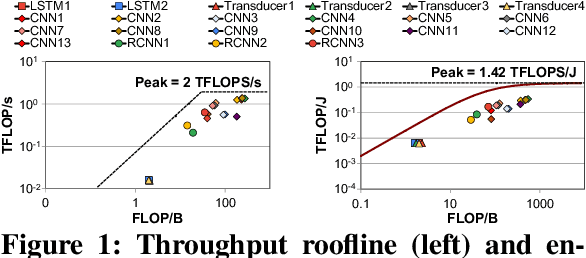
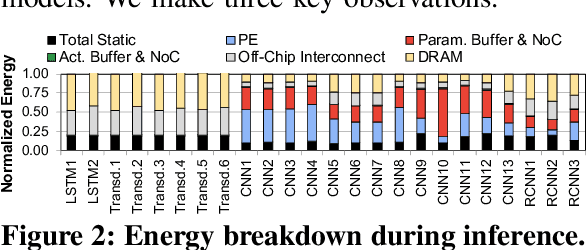
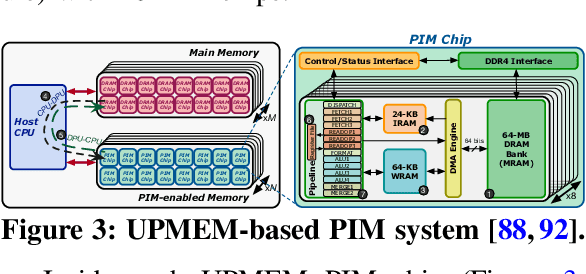

Abstract:Neural networks (NNs) are growing in importance and complexity. A neural network's performance (and energy efficiency) can be bound either by computation or memory resources. The processing-in-memory (PIM) paradigm, where computation is placed near or within memory arrays, is a viable solution to accelerate memory-bound NNs. However, PIM architectures vary in form, where different PIM approaches lead to different trade-offs. Our goal is to analyze, discuss, and contrast DRAM-based PIM architectures for NN performance and energy efficiency. To do so, we analyze three state-of-the-art PIM architectures: (1) UPMEM, which integrates processors and DRAM arrays into a single 2D chip; (2) Mensa, a 3D-stack-based PIM architecture tailored for edge devices; and (3) SIMDRAM, which uses the analog principles of DRAM to execute bit-serial operations. Our analysis reveals that PIM greatly benefits memory-bound NNs: (1) UPMEM provides 23x the performance of a high-end GPU when the GPU requires memory oversubscription for a general matrix-vector multiplication kernel; (2) Mensa improves energy efficiency and throughput by 3.0x and 3.1x over the Google Edge TPU for 24 Google edge NN models; and (3) SIMDRAM outperforms a CPU/GPU by 16.7x/1.4x for three binary NNs. We conclude that the ideal PIM architecture for NN models depends on a model's distinct attributes, due to the inherent architectural design choices.
LEAPER: Modeling Cloud FPGA-based Systems via Transfer Learning
Aug 22, 2022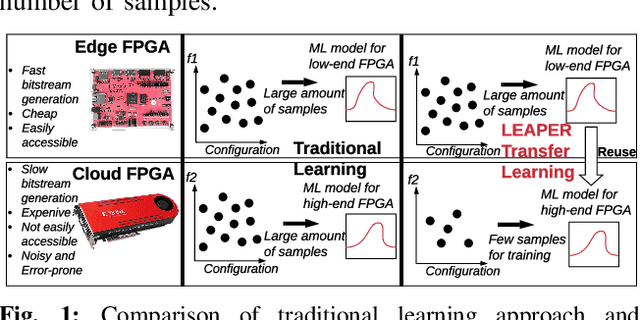
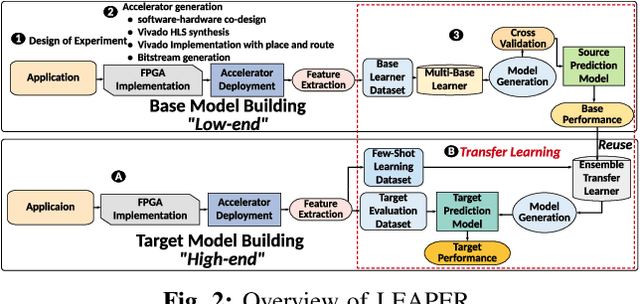

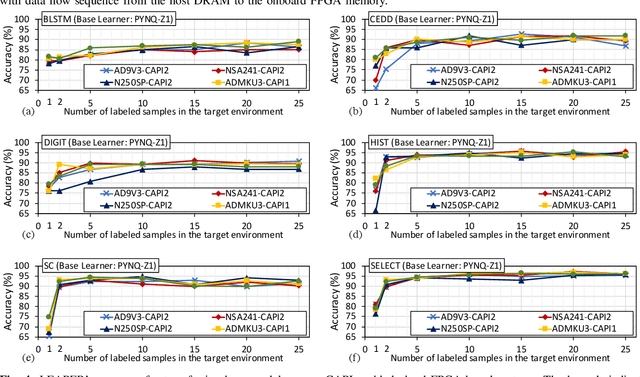
Abstract:Machine-learning-based models have recently gained traction as a way to overcome the slow downstream implementation process of FPGAs by building models that provide fast and accurate performance predictions. However, these models suffer from two main limitations: (1) training requires large amounts of data (features extracted from FPGA synthesis and implementation reports), which is cost-inefficient because of the time-consuming FPGA design cycle; (2) a model trained for a specific environment cannot predict for a new, unknown environment. In a cloud system, where getting access to platforms is typically costly, data collection for ML models can significantly increase the total cost-ownership (TCO) of a system. To overcome these limitations, we propose LEAPER, a transfer learning-based approach for FPGA-based systems that adapts an existing ML-based model to a new, unknown environment to provide fast and accurate performance and resource utilization predictions. Experimental results show that our approach delivers, on average, 85% accuracy when we use our transferred model for prediction in a cloud environment with 5-shot learning and reduces design-space exploration time by 10x, from days to only a few hours.
An Experimental Evaluation of Machine Learning Training on a Real Processing-in-Memory System
Jul 16, 2022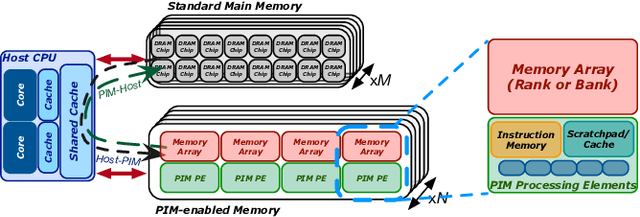
Abstract:Training machine learning (ML) algorithms is a computationally intensive process, which is frequently memory-bound due to repeatedly accessing large training datasets. As a result, processor-centric systems (e.g., CPU, GPU) suffer from costly data movement between memory units and processing units, which consumes large amounts of energy and execution cycles. Memory-centric computing systems, i.e., with processing-in-memory (PIM) capabilities, can alleviate this data movement bottleneck. Our goal is to understand the potential of modern general-purpose PIM architectures to accelerate ML training. To do so, we (1) implement several representative classic ML algorithms (namely, linear regression, logistic regression, decision tree, K-Means clustering) on a real-world general-purpose PIM architecture, (2) rigorously evaluate and characterize them in terms of accuracy, performance and scaling, and (3) compare to their counterpart implementations on CPU and GPU. Our evaluation on a real memory-centric computing system with more than 2500 PIM cores shows that general-purpose PIM architectures can greatly accelerate memory-bound ML workloads, when the necessary operations and datatypes are natively supported by PIM hardware. For example, our PIM implementation of decision tree is $27\times$ faster than a state-of-the-art CPU version on an 8-core Intel Xeon, and $1.34\times$ faster than a state-of-the-art GPU version on an NVIDIA A100. Our K-Means clustering on PIM is $2.8\times$ and $3.2\times$ than state-of-the-art CPU and GPU versions, respectively. To our knowledge, our work is the first one to evaluate ML training on a real-world PIM architecture. We conclude with key observations, takeaways, and recommendations that can inspire users of ML workloads, programmers of PIM architectures, and hardware designers & architects of future memory-centric computing systems.
Machine Learning Training on a Real Processing-in-Memory System
Jun 13, 2022
Abstract:Training machine learning algorithms is a computationally intensive process, which is frequently memory-bound due to repeatedly accessing large training datasets. As a result, processor-centric systems (e.g., CPU, GPU) suffer from costly data movement between memory units and processing units, which consumes large amounts of energy and execution cycles. Memory-centric computing systems, i.e., computing systems with processing-in-memory (PIM) capabilities, can alleviate this data movement bottleneck. Our goal is to understand the potential of modern general-purpose PIM architectures to accelerate machine learning training. To do so, we (1) implement several representative classic machine learning algorithms (namely, linear regression, logistic regression, decision tree, K-means clustering) on a real-world general-purpose PIM architecture, (2) characterize them in terms of accuracy, performance and scaling, and (3) compare to their counterpart implementations on CPU and GPU. Our experimental evaluation on a memory-centric computing system with more than 2500 PIM cores shows that general-purpose PIM architectures can greatly accelerate memory-bound machine learning workloads, when the necessary operations and datatypes are natively supported by PIM hardware. To our knowledge, our work is the first one to evaluate training of machine learning algorithms on a real-world general-purpose PIM architecture.
Heterogeneous Data-Centric Architectures for Modern Data-Intensive Applications: Case Studies in Machine Learning and Databases
May 29, 2022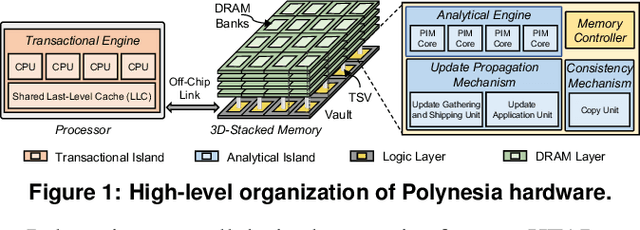
Abstract:Today's computing systems require moving data back-and-forth between computing resources (e.g., CPUs, GPUs, accelerators) and off-chip main memory so that computation can take place on the data. Unfortunately, this data movement is a major bottleneck for system performance and energy consumption. One promising execution paradigm that alleviates the data movement bottleneck in modern and emerging applications is processing-in-memory (PIM), where the cost of data movement to/from main memory is reduced by placing computation capabilities close to memory. Naively employing PIM to accelerate data-intensive workloads can lead to sub-optimal performance due to the many design constraints PIM substrates impose. Therefore, many recent works co-design specialized PIM accelerators and algorithms to improve performance and reduce the energy consumption of (i) applications from various application domains; and (ii) various computing environments, including cloud systems, mobile systems, and edge devices. We showcase the benefits of co-designing algorithms and hardware in a way that efficiently takes advantage of the PIM paradigm for two modern data-intensive applications: (1) machine learning inference models for edge devices and (2) hybrid transactional/analytical processing databases for cloud systems. We follow a two-step approach in our system design. In the first step, we extensively analyze the computation and memory access patterns of each application to gain insights into its hardware/software requirements and major sources of performance and energy bottlenecks in processor-centric systems. In the second step, we leverage the insights from the first step to co-design algorithms and hardware accelerators to enable high-performance and energy-efficient data-centric architectures for each application.
Sibyl: Adaptive and Extensible Data Placement in Hybrid Storage Systems Using Online Reinforcement Learning
May 15, 2022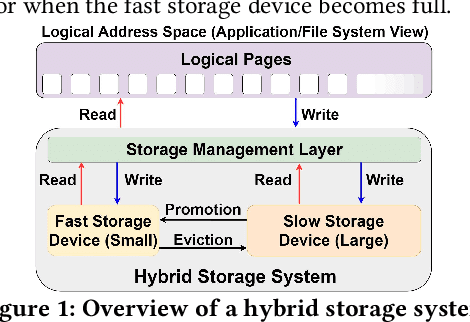

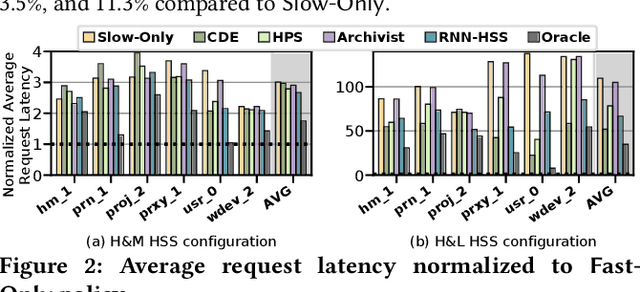

Abstract:Hybrid storage systems (HSS) use multiple different storage devices to provide high and scalable storage capacity at high performance. Recent research proposes various techniques that aim to accurately identify performance-critical data to place it in a "best-fit" storage device. Unfortunately, most of these techniques are rigid, which (1) limits their adaptivity to perform well for a wide range of workloads and storage device configurations, and (2) makes it difficult for designers to extend these techniques to different storage system configurations (e.g., with a different number or different types of storage devices) than the configuration they are designed for. We introduce Sibyl, the first technique that uses reinforcement learning for data placement in hybrid storage systems. Sibyl observes different features of the running workload as well as the storage devices to make system-aware data placement decisions. For every decision it makes, Sibyl receives a reward from the system that it uses to evaluate the long-term performance impact of its decision and continuously optimizes its data placement policy online. We implement Sibyl on real systems with various HSS configurations. Our results show that Sibyl provides 21.6%/19.9% performance improvement in a performance-oriented/cost-oriented HSS configuration compared to the best previous data placement technique. Our evaluation using an HSS configuration with three different storage devices shows that Sibyl outperforms the state-of-the-art data placement policy by 23.9%-48.2%, while significantly reducing the system architect's burden in designing a data placement mechanism that can simultaneously incorporate three storage devices. We show that Sibyl achieves 80% of the performance of an oracle policy that has complete knowledge of future access patterns while incurring a very modest storage overhead of only 124.4 KiB.
 Add to Chrome
Add to Chrome Add to Firefox
Add to Firefox Add to Edge
Add to Edge